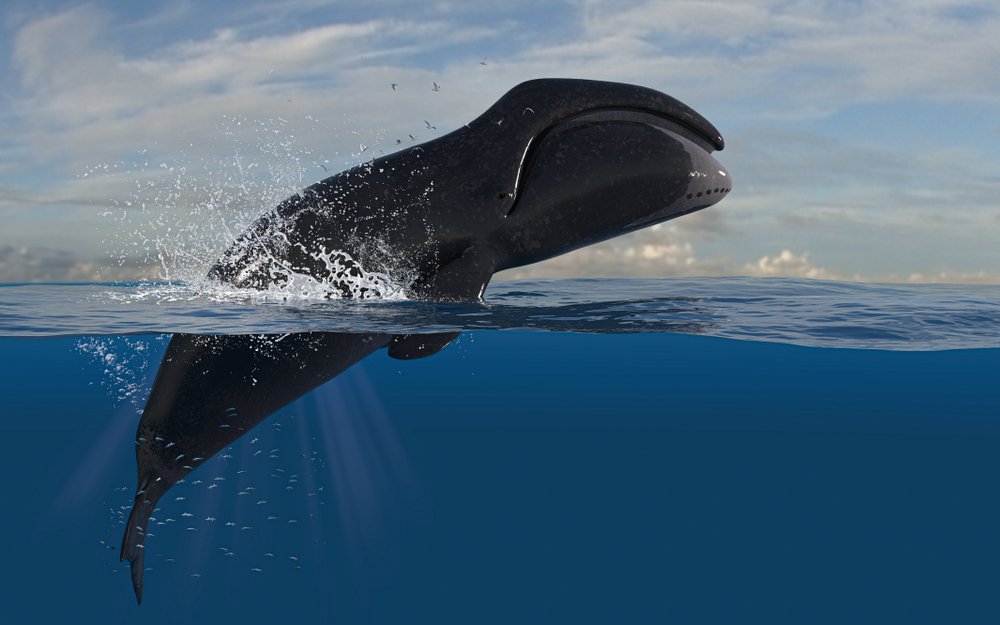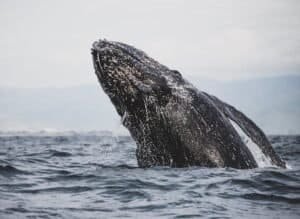Have you ever wondered that How Long Can Bowhead Whales Live? The oldest known whales are the Bowhead Whales or Greenland Right Whales. It is estimated that they can live up to 200 years, making them not only the longest lived whales, but one of the longest lived animals on earth. Bowhead whales are one of the most fascinating whale species that exist in our oceans today. These enormous and majestic creatures can be found swimming through the icy waters of the Arctic, where they spend most of their lives.
Table of Contents
Physical Characteristics of Bowhead Whales
Bowhead whales are easily recognizable due to their massive size. On average, these mammals can reach lengths of up to 50 feet and weigh around 60 tons. They have a distinctive triangular-shaped skull, which is especially adapted for breaking through thick ice sheets. This feature allows them to easily navigate through their Arctic habitat. Their bodies are mostly black in color, with some spots of white on their bellies and chin.
Aside from their size, bowhead whales are also known for their incredibly long lifespan. In fact, they are one of the longest-living mammals on Earth, with some individuals living well over 200 years. This remarkable longevity has fascinated scientists for centuries, leading to numerous studies on the aging process and biology of bowhead whales.
Average Lifespan Of Bowhead Whales

However, the exact average lifespan of these creatures is still a subject of debate among scientists. Some researchers estimate that the average lifespan ranges from 100 to 150 years, while others believe it could be much longer.
How Long Can Bowhead Whales Live? Factors That Contribute to their Longevity
The exact reasons behind the incredible lifespan of bowhead whales are still somewhat of a mystery. However, there are several factors that are believed to contribute to their ability to live for such an extended period of time.
Slow Metabolism
One possible explanation is the slow metabolism of bowhead whales. They have been observed to have a significantly lower metabolic rate compared to other whale species, meaning they use less energy and therefore age at a slower rate. Additionally, they have a thick layer of blubber that helps insulate them from the frigid Arctic waters, further slowing down their metabolism.
Lack of Predators
Another factor that may contribute to their long lifespan is the lack of natural predators in their environment. Bowhead whales are at the top of the food chain in the Arctic, so they do not have to worry about being hunted by other animals. This reduces their risk of mortality and allows them to live longer.
Genetic Adaptations
Recent studies have also shown that bowhead whales possess unique genetic adaptations that may play a role in their longevity. These include DNA repair mechanisms and changes in gene expression, which help protect their cells from damage and slow down the aging process.
Reproductive Lifecycle
Interestingly, bowhead whales also have a slow reproductive cycle. Females reach sexual maturity around 25 years of age, and they give birth to just one calf every 3-5 years. This slow reproductive rate may allow them to conserve energy and resources for their own survival, contributing to their longer lifespan.
Impact of Environment on Bowhead Whale’s Lifespan

While bowhead whales have a remarkable lifespan, their environment also plays a significant role in their longevity. Climate change and human activities such as pollution and noise disturbance can negatively impact these creatures and potentially shorten their lifespan.
Role Of Behavior And Diet In Bowhead Whale’s Lifespan
The behavior and diet of bowhead whales also contribute to their long lifespan. These creatures are known to have a diverse diet, feeding on a variety of small fish, plankton, and krill. This ensures that they get all the necessary nutrients to maintain their health and longevity.
Additionally, bowhead whales have been observed to exhibit social behaviors that may also play a role in their longevity. They are known to form close bonds and have complex communication systems, which may help reduce stress and increase their overall well-being.
What Is The Natural Predators Of Bowhead Whales?

While bowhead whales do not have any natural predators, they are currently facing significant threats from human activities such as commercial whaling and climate change. But with proper conservation efforts and protection of their Arctic habitat, these incredible creatures can continue to thrive for many more years to come.
Climate Change Effects On Bowhead Whale’s Lifespan
Climate change poses a significant threat to the longevity of bowhead whales. As the Arctic sea ice continues to melt, these animals may lose their primary food source and face increased competition from other whale species. Additionally, changes in water temperature and acidity can also have adverse effects on their health.
Contrast Of Bowhead Whales with Other Whale Lifespans
Compared to other whale species, such as the blue whale which has an average lifespan of 80-90 years, bowhead whales have a much longer lifespan. This makes them truly unique creatures in the animal kingdom and highlights the importance of studying and protecting them for future generations.
What Is The Conservation Efforts For The Bowhead Whales
Despite their impressive lifespan, bowhead whales are currently listed as an endangered species due to centuries of commercial whaling. However, conservation efforts have been put in place to protect these magnificent creatures. Hunting of bowhead whales is now banned, and their populations are slowly recovering. It is hoped that with continued conservation efforts, these amazing animals will continue to thrive in our oceans for many more years to come.
The Importance of Protecting Bowhead Whales
Given their long lifespan and vital role in the Arctic ecosystem, it is crucial to protect bowhead whales from human activities such as commercial whaling and climate change. These threats not only impact the survival of individual whales but also have a significant impact on the entire population.
By learning more about these magnificent creatures and implementing conservation efforts, we can ensure the continued survival of bowhead whales for generations to come.
Final Thoughts
Bowhead whales are truly remarkable creatures that continue to fascinate scientists and marine enthusiasts alike. Their incredible lifespan is just one of the many fascinating aspects of their biology. By understanding and protecting these animals, we can ensure that they remain a vital part of our oceans for years to come.
Read Also: How Many Grey Whales Are Left In The World?





